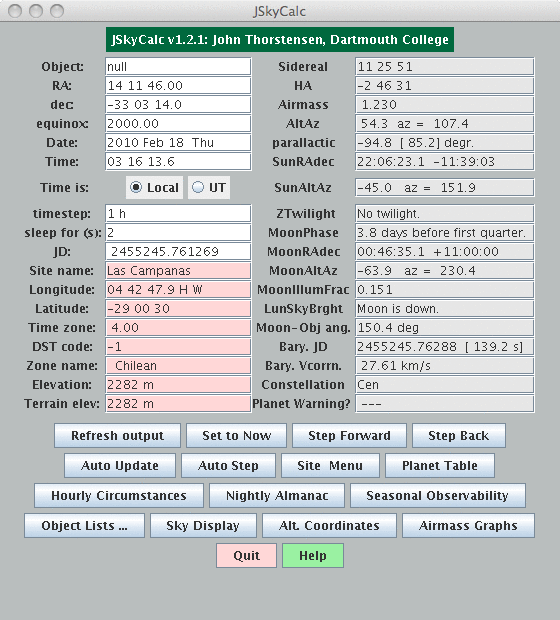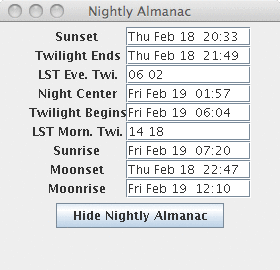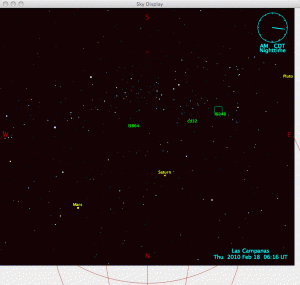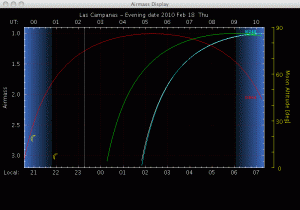JSkyCalc is an easy-to-install ephemeris tool that helps you plan your observing runs, then carry them out as efficiently as possible. It’s a graphical revival of the venerable Skycalc by John Thorstensen of Dartmouth.
Airmass-plotting tools exist for ESO and Keck. The advantage of JSkyCalc is that it calculates everything you’ll need for observing, and it knows all major observatories—one tool can plan all your runs.
There are 2 versions of JSkyCalc: a web version, and a downloadable version. I recommend downloading it, so that you can load lists of targets. On my Mac (OS X 10.5), a simple double-click of “JSkyCalc.jar” starts the program.
Here’s a simple demo. Start JSkyCalc and select an observatory. The main screen looks like this:

Enter a date & time (there’s a button for “now”). Hit “Nightly Almanac” to see the times of sunset, sunrise, and twilight. Hit “Object Lists” and load a set of objects; in this example I’ve loaded three standard stars. (Hit “Help” to learn the catalog format.)

Select all targets with shift-click. The “Sky Display” window shows you the positions of your objects with respect to the constellations and the moon.

At the telescope, hit “Set to Now” to show current conditions. Even better, you can ask JSkyCalc to update in real time: try setting “sleep” to ~60 s, and hit “Auto Update.” Select all targets, and check the airmass graph: a vertical bar shows you the current time. This is a handy aid for deciding when to switch targets and observe standard stars.
That’s just a quick look. JSkyCalc’s “Help” button has more details.
Two grumbles so far: First, I can’t figure out how to PRINT! I’m currently screen grabbing the airmass plot, and using “convert -negate” to make a printer-friendly version. Anyone know a better way? Second, since Keck has unique pointing constraints, you still need to use their tool to calculate how far down in elevation you can follow a given source.
JSkyCalc, free

JSkyCalc has become my favorite observing planning tools. There are many more functions than Jane mentions (and many more than I’ve used). Some of my favorites are the seasonal visibility, including hours per night above certain airmasses as a function of both dark and bright time, estimates of the local sky brightness due to the lunar phase and position, and warnings if the moon or a planet is close to your target.
I don’t think that it is currently capable of printing, but I bet if you ask John Thorstensen he’ll work on it some night when he’s bored. My own wish would be to have it as an iPhone app; I could use fast access to these planning tools during conference dinners.
I’ve found JSkyCalc extremely useful when I’m at the telescope in crisis mode. (For planning, I just use some IDL scripts and intuition.) When certain regions of the sky are inaccessible for a variety of reasons (clouds, windshake, the moon, or laser collisions), the sky view in JSkyCalc helps me figure out which targets I can actually do in real time. This is not a simple task without a visualizer, as I’m usually picking from ~80 targets or so that are all over the sky (brown dwarfs, etc.).
I think the feature that I like most is the fact that it can accept Keck-style starlists as is, which makes it super easy to use.
There is also a wiki entry for pre-observing tools: Airmass and Visibility Plots.
The current link to Jskycalc leads to the official Dartmouth webpage – is the link still broken ( I remember some discussion on it on the FB astronomers group in Sept)? I also couldn’t find the link for downloading it via google searches and other links – they all lead to the Dartmouth webpage. Thanks!
D’uh (or however you spell it) – it’s on the following website
http://www.dartmouth.edu/~physics/labs/skycalc/flyer.html
Hi,
I would like to use Jskycalc as all of you do, but when I click on the provided links, I reach directly a website called Dart Mouth which is related to Astrophysics but I can’t find any true link of dowloading the program in this website
Thanks for your help,
Kind regards,
Gaël,
Master degree in Cosmology and Astrophysics, Montpellier II University
May I suggest a no-installation, in-browser alternative with lots of additional infos and customization, as well as tracking, horizon masks and more?
https://www.arcsecond.io/iobserve